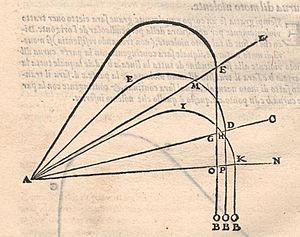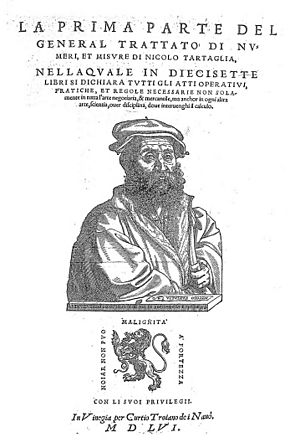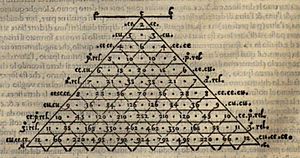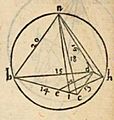Nicolo Tartaglia facts for kids
Quick facts for kids
Tartaglia
|
|
|---|---|
 |
|
| Born | 1499/1500 |
| Died | 13 December 1557 |
| Nationality | Italian |
| Known for | Cardano–Tartaglia formula Early research into ballistics Tartaglia's triangle |
| Scientific career | |
| Fields | Mathematics, engineering |
| Notable students | Ostilio Ricci |
Niccolò Fontana, known as Tartaglia (meaning "stammerer"), was a famous Italian mathematician and engineer. He lived from around 1499/1500 to 1557 in the Republic of Venice. Tartaglia was a true Renaissance man. He designed forts, surveyed land, and worked as a bookkeeper.
He published many important books. These included the first Italian translations of ancient Greek thinkers like Archimedes and Euclid. He also created a huge collection of mathematical knowledge. Tartaglia was the first to use math to study how cannonballs fly. This field is called ballistics. His ideas were later improved by Galileo.
Contents
Early Life and Challenges
Niccolò was born in Brescia. His father, Michele, delivered mail but was sadly killed by robbers in 1506. This left Niccolò, his two siblings, and his mother very poor.
More trouble came in 1512. French soldiers attacked Brescia during a war. The city fought for seven days. When the French broke through, they attacked the people. Over 45,000 residents were killed. Niccolò and his family hid in a church. But a French soldier found them and wounded Niccolò. His mother helped him get better. However, the injury left him with a speech problem. This is how he got the nickname "Tartaglia," which means "stammerer." He grew a beard after that to hide his scars.
Tartaglia's original family name is not fully clear. Some say it was "Fontana."
He started learning to write around age 14. But he soon couldn't pay his teacher anymore. He later wrote that from then on, he taught himself. He studied old books by himself, driven by his strong desire to learn.
Around 1517, Tartaglia moved to Verona. Then, in 1534, he moved to Venice. Venice was a major trading city and a center for new ideas in Italy. It was also a leading place for printing books. This meant even poor students like Tartaglia could find old texts. For example, he found a Latin book by Archimedes in 1531, which he said was "in the hands of a sausage-seller in Verona."
Tartaglia made a living by teaching practical math. He taught in schools called abacus schools. He also gave advice to people like gunners and architects for a small fee.
Understanding How Cannonballs Fly
Tartaglia's first published book was Nova Scientia (A New Science) in 1537. This book was very important for understanding how things move. It was the first to turn the practical knowledge of early artillerists (people who used cannons) into a scientific and mathematical study.
Before Tartaglia, people often used old ideas from Aristotle to describe how things moved. These ideas didn't use much math. Tartaglia changed this by using mathematical models. He showed that to make a cannonball go the farthest, you should fire the cannon at a 45-degree angle.
Tartaglia believed a cannonball flew in three parts. First, it went in a straight line from the cannon. Then, it curved downwards in a circular path. Finally, it dropped straight to the ground. He used math to figure out the length of that first straight path.
Tartaglia's work on military science became very popular across Europe. Gunners used his ideas for a long time. Even Galileo, who later improved on Tartaglia's ideas, studied his books carefully.
Translating Ancient Knowledge
In Tartaglia's time, people started to see that math was key to understanding physics. In 1543, Tartaglia published a Latin version of some of Archimedes' works. These included Archimedes' writings on parabolas, circles, and floating objects. Some of these had never been published before. Tartaglia later published Italian versions too. Galileo likely learned about Archimedes through these widely available books.
Tartaglia also published the first translation of Euclid's Elements into a modern European language, Italian, in 1543. For 200 years, Euclid's work was taught using Latin translations that had errors. Tartaglia's version was based on a correct Greek text. It fixed the errors and made Euclid's important ideas available to more people. This helped spread mathematical knowledge beyond universities.
His Great Math Book
Tartaglia was a master of practical math. He taught the kind of math used in business, which had been popular in Italy for centuries. Teachers like him taught with paper and pen, showing students how to solve problems step-by-step.
Tartaglia's most famous work was the General Trattato di Numeri et Misure (General Treatise on Number and Measure). This was a huge, 1500-page encyclopedia written in the Venetian language. It had six parts. The first three came out in 1556, around the time of his death. The last three were published after he died.
One historian called it "the best treatise on arithmetic that appeared in Italy in his century." It covered everything from basic math operations to business rules. It showed how people lived and how merchants worked in the 16th century.
Part I of the book was about business math. It explained how to work with different money types, exchange currencies, calculate interest, and divide profits. It had many examples and rules that people could use right away.
Part II covered more general math problems. This included things like powers, and what we now call Tartaglia's triangle.
Tartaglia's Triangle
Tartaglia was very good at working with binomial expansions. These are ways to multiply expressions like (a+b) raised to a power. He included many examples in his General Trattato.
He knew about what is now called Pascal's triangle a hundred years before Pascal. This triangle of numbers helps find the coefficients (the numbers in front of the variables) in binomial expansions. Tartaglia showed how the numbers in the triangle are formed by adding the two numbers above them. For example, 15 and 20 in one row add up to 35, which is below them in the next row.
Solving Cubic Equations
Tartaglia is also famous for his disagreements with another mathematician, Gerolamo Cardano. In 1539, Cardano convinced Tartaglia to share his secret method for solving cubic equations. These are equations where the highest power of the unknown number is three (like x³). Tartaglia shared his solutions, but made Cardano promise not to publish them.
A few years later, Cardano saw some unpublished work by Scipione del Ferro. Del Ferro had found the same solution as Tartaglia independently. Since del Ferro's work was older, Cardano felt he could break his promise. He included Tartaglia's solution in his next book. Even though Cardano gave Tartaglia credit, Tartaglia was very angry. This led to a famous public math challenge between Tartaglia and Cardano's student, Ludovico Ferrari.
Today, math historians give credit to both Cardano and Tartaglia for the formula to solve cubic equations. It is now called the "Cardano–Tartaglia formula".
Images for kids
See also
 In Spanish: Niccolò Fontana Tartaglia para niños
In Spanish: Niccolò Fontana Tartaglia para niños





